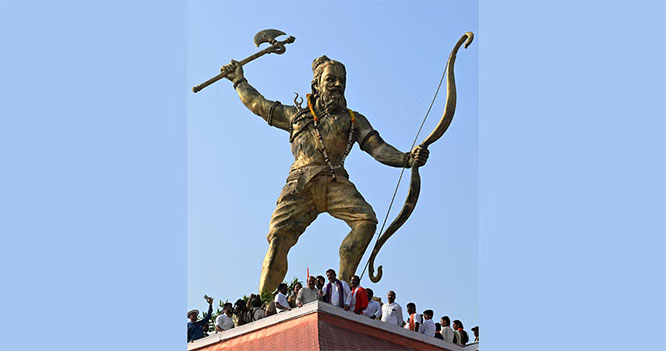On the eve of 43rd anniversary of the Emergency, which was imposed on the country in 1975, BJP has come out strongly condemning the event, has issued half page advertisement and Modi said that it was imposed to save the power of a family. There are claims that BJP’s parent organization RSS and its political predecessors valiantly fought against emergency. Surprisingly many streams of Indian politics, like CPI (M), shades of socialists, and sections of dissident Congress streams who fought against Emergency did not make any noise about their role. While Congress itself has not overtly criticized the act of its leader Indira Gandhi, it needs to be recalled that Mrs. Gandhi had regretted the excesses during this period in a speech in Yavatmal in 1978. Apart from Jaitly and BJP leaders there are many others also who compare the authoritarian regime and its excesses with what happened during Hitler’s fascist regime.
It’s true that during this period there was a serious violation of democratic freedoms. The similarity with Hitler’s fascist regime ends here. The main mechanism of Hitler’s regime was to instigate emotions, ntensifying divisiveness by activating the storm troopers and targeting against the racial minority; the Jews. Other characteristics of his regime were to promote the interests of big business houses and suppress the rights of working class in particular. It projected the golden past and also promoted ultra nationalism and implemented muscular foreign policy leading the soured relations with neighbors. People like Einstein left the country. The targeting of racial minorities was the central and most conspicuous part of the policy. The excesses which took place during emergency were not targeting any minority. It’s true that the pavement dwellers suffered a lot, demolitions and the compulsory vasectomy of poor sections affected Muslims as well, but it was not targeted against Muslim community in any way.
How can one say that Emergency which was authoritarianism was not fascism in any way? In fascist methods what is central to the undermining of democracy is to operate through the mechanism of mobilization of foot soldiers, whipping up mass hysteria and giving prominence to emotive issues. Let’s remember Indira Gandhi herself had lifted the Emergency and called for elections in a democratic way, elections in which she suffered a massive defeat. In Germany fascist regime destroyed Germany itself.
While a lot is being said about emergency, what was the role of RSS during this period? The claims that RSS was a central force to fight against this regime are a cock and bull story. TV Rajeswar, who served as Governor of Uttar Pradesh and Sikkim after his retirement from service, in his book, ‘India: The Crucial Years” [Harper Collins] tells us “Not only they (RSS) were supportive of this [Emergency], they wanted to establish contact apart from Mrs. Gandhi, with Sanjay Gandhi also”. Rajeswar in an interview with Karan Thapar disclosed that Deoras “quietly established a link with the PM’s house and expressed strong support for several steps taken to enforce order and discipline in the country. Deoras was keen to meet Mrs. Gandhi and Sanjay. But Mrs. Gandhi refused.”As a matter of fact the executioners of emergency excesses found good favor with BJP as it was formed after Jana Sangh component leaving the Janata Party. One recalls the emergency time slogan, “Aapatkal ke tin dalal: Sanjay, Vidya, Bansilal” (three executioners of Emergency: Sanjay, Vidya, Bansilal). Later BJP gave ticket to Vidya Charan Shukla, and allied with Bansilal to form the Government in Haryana. Sanjay Gandhi’s wife Maneka was taken in to BJP and became minister without ever condemning the excesses committed during that period.
As a matter of fact what is happening today is much more repressive though there is no official emergency. Many have labeled it as undeclared emergency. Nayantara Sahgal, who was a strong critic of Emergency, has stated very aptly that “…we have an undeclared Emergency; there is no doubt about that. We have seen a huge, massive attack on the freedom of expression.” The observation is that there are killings of innocent, helpless Indians killed because they did not fit into the RSS’s view of India. Every dissent is labeled as anti-National. She continues “Writers like Gauri Lankesh have been killed. And there has been no justice for the families of the wage earners who have lost their lives in this fashion. In fact they are now being called the accused. So we have a horrendous situation, a nightmare which is worse than the Emergency.” Similarly we know that today the dangers to civic liberties and democratic rights is through the ideologically indoctrinated foot soldiers, who have been called fringe elements, but as such they are part of a clear division of labor, working against Indian Constitution and for Hindu Nation.
The prevalence of violence against religious minorities, the intimidation, the lynching in the name of Holy cow, beef, love jihad, ghar wapasi has become a sort of New Normal of present regime. It not only goes beyond the authoritarian regime but borders on the divisive politics which is out to relegate the religious minorities to second class status in the country. While the top rulers keep quiet in cases of serious violations, the ground level vigilantes have a field day in furthering the agenda which is outcome of RSS ideology. Lately even the use of tricolor to instigate violence as witnessed in Kasgaonj is further stifling our democracy.
We need to distinguish between the authoritarian regime of Emergency where the machinery of state was used to suppress democratic rights with fascist regimes which are guided by narrow nationalism and target the minorities while pushing forward Hindu nationalism and bringing in divisions in society on sectarian grounds. Democracy is stifled in both cases, but in narrow nationalism the very concept of citizenship is denied to the sections o society on the grounds of their religion or race. And this is the crucial marker of sectarian nationalism.







Comments
Add new comment